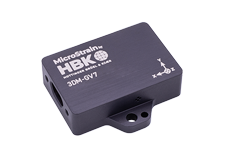FAQs
Videos
Yes, the 3DM-GX5-35 programming interface is comprised of a compact set of setup and control commands and a very flexible user-configurable data output format. The commands and data are divided into three command sets and two data sets corresponding to the internal architecture of the device. The three command sets consist of a set of “Base” commands (a set that is common across many types of devices), a set of unified “3DM” (3D Motion) commands that are specific to the LORD Sensing inertial product line, and a set of “System” commands that are specific to sensor systems comprised of more than one internal sensor block. The data sets represent the two types of data that the 3DM-GX5-35 is capable of producing: "GNSS" (Global Navigation Satellite System) data and “IMU” (Inertial Measurement Unit) data.
Base commands: Ping, Idle, Resume, Get ID Strings, etc.
3DM commands: Poll IMU Data, Estimation Filter Data, etc.
System commands: Switch Communications Mode, etc.
IMU data: Acceleration Vector, Gyro Vector, etc.
GNSS data: GNSS Position, Velocity, Satellite Data, Fix Data, etc.
The protocol is packet based. All commands, replies, and data are sent and received as fields in a message packet. Commands are all confirmed with an ack/nack (with a few exceptions). The packets have a descriptor type field based on their contents, so it is easy to identify if a packet contains IMU data, GNSS data, commands, or replies.
To enable customers to try our products risk free, LORD Sensing MicroStrain offers a 30-day return on the purchase of a starter kit. In order to take advantage of this offer, a purchase order or payment for the starter kit is required when the order is placed. If the product is not suited to the application, the product may be returned within 30 days from the date of receipt for a full refund (excluding shipping and handling), as long as the product is unaltered or undamaged. Items can only be returned after LORD Sensing MicroStrain has issued an RMA. Items must be packed to withstand shipping and returned freight pre-paid. LORD Sensing MicroStrain will inspect the items returned and issue a refund or credit once the items have been examined and are deemed to be unaltered or undamaged. Non-standard or custom products may only be returned with LORD Sensing MicroStrain's approval and a re-stocking penalty may be assessed. A 30-Day Return must be initiated by receiving an RMA (Returned Merchandise Authorization from LORD Sensing MicroStrain.
The Terms and Conditions of Sale for this inertial sensor can be found here.
When you receive your inertial sensor, you can immediately begin operating it with our SensorConnect software.
SensorConnect is a Microsoft Windows-based out-of-the-box software utility that allows users to fully configure and operate inertial sensors, as well as store, display, and export data. Many users will be able to accomplish their use of the inertial sensor with just SensorConnect.
Click here to learn more and download SensorConnect.
SensorConnect does not guarantee full support of legacy products. Click here for a comple list of inertial products supported by SensorConnect.
MIP Monitor remains available for use with legacy products. Click here to download MIP Monitor.
If one was to attempt dead reckoning, one would follow this path:
1: The inertial sensor provides acceleration with respect to its body-fixed coordinate system. This must be transformed into a coordinate system fixed to the earth. In order to accomplish this, it is necessary to know the orientation of the inertial sensor relative to the earth-fixed coordinate system.
2. Subtract the gravity vector.
3. Double integrate (WRT time) the acceleration.
Note that any small errors in either the orientation estimate, or the sensor’s acceleration bias, or the knowledge of the gravity vector will result in exponentially increasing errors. The size of these errors has no bounds.
We generally do not recommend our sensors for applications involving position measurement due the exceptional difficultly of such computations.
Even the best systems, costing hundreds of thousands of dollars, are subject to error accumulation on the order of 1 kilometer per hour.
The bias errors of the industrial grade accelerometers used in the inertial sensor will produce errors of many kilometers within seconds.
This assumes that the orientation is known perfectly.
Uncertainty in the orientation measurement will make the errors even larger.
These inertial instruments use MEMS sensors (accelerometers, gyroscopes).
These MEMS sensors are classified as 'automotive' or ‘industrial’ grade.
They are not 'tactical' or 'navigational' grade.
The bottom line is that the inertial sensor cannot directly provide a displacement measurement.
Let us also be very clear that this statement is not meant to dissuade you; it is meant to set the tone for the complexity involved in this application.
Papers such as this discuss the science involved in great detail: https://www.google.com/url?sa=t&rct=j&q=&esrc=s&source=web&cd=1&ved=0ahUKEwiCsraTjO3RAhWj24MKHXIvBIAQFggaMAA&url=https%3A%2F%2Fsciforum.net%2Fconference%2Fecsa-1%2Fpaper%2F2395%2Fdownload%2Fpdf&usg=AFQjCNEqcxQZFt3dmpiyKJOTzcNXiwgnzA&cad=rja[na01.safelinks.protection.outlook.com]
Vibration impacts MEMS-based inertial sensors; this is true for our inertial sensors or any other manufacturers.
Every effort must be made to eliminate vibration.
Vibration in the environment frame can significantly degrade the performance of the inertial sensor, particularly constant, unchanging vibration.
Strong, continuous vibrations appear as unaccounted noise to the filter, degrading its performance.
The accelerometers can't tell the difference between vibration and acceleration, and therefore the filter receives erroneous input.
We would suggest using some vibration damping materials to mount the inertial sensor.
Here are some product manufacturers:
· http://www.earsc.com/
· http://www.sorbothane.com/
Here is an on-line source for ordering small quantities, small squares of material: http://www.mcmaster.com/#ultra-soft-polyurethane/=gai91i
The idea is to place the pad between the vehicle frame and the inertial sensor to isolate the inertial sensor.
There are many ways to physically accomplish this damping.
As an example, you could mount the inertial sensor on the aluminum plate and place a Sorbothane pad between the plate and the vehicle frame.
Sorbothane can be purchased with double-sided adhesive.
Be careful not to defeat the isolation by using through-bolts that transfer the vehicle frame vibration to the inertial sensor (or in this example, the aluminum plate holding it).










